Seismic Signals of the Wushi MS7.1 Earthquake of 23 January 2024, Viewed Through the Angle of Hydrogeochemical Characteristics
Abstract
1. Introduction
2. Background
3. Sampling and Analytical Methods
4. Results
5. Discussion
5.1. Hydrochemical Characteristics and Evolution of Spring Water
5.1.1. Hydrochemical Facies and Mixing Indicators
5.1.2. Isotopic Tracing of Recharge and Flow Depth
5.1.3. Fluid Maturity and Geothermal Equilibrium
5.1.4. Reservoir Temperature and Circulation Depth Estimates
5.2. Isotopic Characteristics and Genesis of Spring Gas
5.3. Interpretation of Earthquake-Induced Anomalies
5.3.1. Major Ions and Isotopic Perspectives on Earthquake Anomalies
5.3.2. Trace Element Signatures of Earthquake Anomalies
5.4. Modeling of Fluid Circulation Processes
6. Conclusions
- [1]
- The hydrogen and oxygen isotope values of the springs in the STS area reveal that the thermal springs primarily originate from atmospheric precipitation and melting snow of the Tianshan Mountains, with a distinct altitudinal effect. The analysis of water chemical types indicates that cold springs are mainly of the Ca-HCO3 and Ca-Mg-Cl types, while thermal springs are of the Na-HCO3 and Na-Cl types. The circulation depth of the springs range from 477 to 4772 m, suggesting that shallow water bodies undergo deep circulation along the fault zone and react fully with the surrounding rocks, carrying a wealth of deep information.
- [2]
- The higher 3He/4He ratios (0.42 Ra and 3.71 Ra) in the thermal spring gases indicate that the mantle-derived helium proportion at S1 is as high as 46.48%, suggesting active deep fluid migration and potential geothermal or tectonic activity in the intersection area of the TFF and MDZ. In contrast, the gases at S13 mainly originate from the crust, showing a lower mantle contribution and weaker tectonic activity. The high Poisson’s ratio at S1 is associated with the enrichment of deep fluids and intense tectonic activity, while the low Poisson’s ratio at S13 reflects the rigidity of the crust and limitations in fluid enrichment, with the gas source primarily being a mixture of shallow crustal gases and gases from the decomposition of organic matter.
- [3]
- There is a close relationship between seismic activity and the distribution of thermal springs in the study area. The consistency between seismic density and intensity and the distribution of thermal springs suggests that seismic activity may influence the hydrogeological characteristics of the thermal springs. Monitoring shows ions and isotopes anomalies, along with trace elements fluctuations, linking seismic events to hydrogeochemistry. These findings highlight the potential of hot spring water chemistry as a valuable precursor for seismic activity, providing critical insights for earthquake forecasting and hydrothermal system dynamics.
- [4]
- The impact of seismic activity on the hydrochemical characteristics of thermal springs is complex and variable. The widespread influence of the Wushi MS7.1 earthquake on the groundwater system indicate that the relationship between seismic activity and fluid anomaly response is regulated by a combination of stress field characteristics, fault locations, and fluid migration pathways, rather than a simple positive correlation with earthquake magnitude.
Supplementary Materials
Author Contributions
Funding
Institutional Review Board Statement
Informed Consent Statement
Data Availability Statement
Conflicts of Interest
References
- İnan, S.; Çetin, H.; Yakupoğlu, N. Spring water anomalies before two consecutive earthquakes (Mw7.7 and Mw7.6) in Kahramanmaraş (Türkiye) on 6 February 2023. Nat. Hazards Earth Syst. Sci. 2024, 24, 397–409. [Google Scholar] [CrossRef]
- Wang, C.Y.; Manga, M. New streams and springs after the 2014 Mw6.0 South Napa earthquake. Nat. Commun. 2015, 6, 7597. [Google Scholar] [CrossRef] [PubMed]
- Zandvakili, Z.; Nishio, Y. Origin of spring waters in the Matsushiro area: Implications for the 1965–1967 earthquake swarm and subsequent “water eruption”. Geochem. J. 2024, 58, 184–193. [Google Scholar] [CrossRef]
- Umeda, K.; Yamazaki, Y.; Sumino, H. Geochemical Signature of Deep Fluids Triggering Earthquake Swarm in the Noto Peninsula, Central Japan. Geophys. Res. Lett. 2024, 51, e2024GL108581. [Google Scholar] [CrossRef]
- Tarantino, S.; Poli, P.; D’Agostino, N.; Vassallo, M.; Festa, G.; Ventafridda, G.; Zollo, A. Non-linear elasticity, earthquake triggering and seasonal hydrological forcing along the Irpinia fault, Southern Italy. Nat. Commun. 2024, 15, 9821. [Google Scholar] [CrossRef]
- Chiodini, G.; Cardellini, C.; Di Luccio, F.; Selva, J.; Frondini, F.; Caliro, S.; Rosiello, A.; Beddini, G.; Ventura, G. Correlation between tectonic CO2 Earth degassing and seismicity is revealed by a 10-year record in the Apennines, Italy. Sci. Adv. 2020, 6, eabc2938. [Google Scholar] [CrossRef]
- Franchini, S.; Agostini, S.; Barberio, M.D.; Barbieri, M.; Billi, A.; Boschetti, T.; Pennisi, M.; Petitta, M. HydroQuakes, central Apennines, Italy: Towards a hydrogeochemical monitoring network for seismic precursors and the hydro-seismo-sensitivity of boron. J. Hydrol. 2021, 598, 125754. [Google Scholar] [CrossRef]
- Skelton, A.; Liljedahl-Claesson, L.; Wästeby, N.; Andrén, M.; Stockmann, G.; Sturkell, E.; Mörth, C.M.; Stefansson, A.; Tollefsen, E.; Siegmund, H.; et al. Hydrochemical Changes Before and After Earthquakes Based on Long-Term Measurements of Multiple Parameters at Two Sites in Northern Iceland—A Review. J. Geophys. Res. Solid Earth 2019, 124, 2702–2720. [Google Scholar] [CrossRef]
- Ntarmouchant, A.; Jeddi, E.M.; Carvalho, M.R.; Bento dos Santos, T.M.; Smaili, H.; Cotrim, B.; Cachapuz, P.; Driouch, Y.; Mali, B.; Ntarmouchant, N.; et al. Thermal springs associated with the Melilla-Fès-Smaala-Oulmès fault (Morocco): The role of fluid geochemistry in identifying a major active geodynamic structure. Appl. Geochem. 2024, 170, 106085. [Google Scholar] [CrossRef]
- Scott, B.E.; Newell, D.L.; Jessup, M.J.; Grambling, T.A.; Shaw, C.A. Structural Controls on Crustal Fluid Circulation and Hot Spring Geochemistry Above a Flat-Slab Subduction Zone, Peru. Geochem. Geophys. Geosyst. 2020, 21, e2020GC008919. [Google Scholar] [CrossRef]
- Kulongoski, J.T.; Hilton, D.R.; Barry, P.H.; Esser, B.K.; Hillegonds, D.; Belitz, K. Volatile fluxes through the Big Bend section of the San Andreas Fault, California: Helium and carbon-dioxide systematics. Chem. Geol. 2013, 339, 92–102. [Google Scholar] [CrossRef]
- Sturrock, C.P.; Catlos, E.J.; Miller, N.R.; Akgun, A.; Fall, A.; Gabitov, R.I.; Yilmaz, I.O.; Larson, T.; Black, K.N. Fluids along the North Anatolian Fault, Niksar basin, north central Turkey: Insight from stable isotopic and geochemical analysis of calcite veins. J. Struct. Geol. 2017, 101, 58–79. [Google Scholar] [CrossRef]
- Tang, J.; Zhou, X.; Zhang, Y.; Tian, J.; He, M.; Li, J.; Dong, J.; Yan, Y.; Liu, F.; Ouyang, S.; et al. Hydrogeochemistry of Fault-Related Hot Springs in the Qaidam Basin, China. Appl. Sci. 2023, 13, 1415. [Google Scholar] [CrossRef]
- Zhou, H.; Zhou, X.; Su, H.; Li, Y.; Liu, F.; Ouyang, S.; Yan, Y.; Bai, R. Hydrochemical Characteristics of Earthquake-Related Thermal Springs along the Weixi–Qiaohou Fault, Southeast Tibet Plateau. Water 2022, 14, 132. [Google Scholar] [CrossRef]
- Zhou, R.; Zhou, X.; Li, Y.; He, M.; Li, J.; Dong, J.; Tian, J.; Li, K.; Yan, Y.; Ouyang, S.; et al. Hydrogeochemical and Isotopic Characteristics of the Hot Springs in the Litang Fault Zone, Southeast Qinghai-Tibet Plateau. Water 2022, 14, 1496. [Google Scholar] [CrossRef]
- Ma, X.; Zhang, L.; Chen, Z.; Shao, Y.; Chen, J.; Ba, R.; Zhang, M.; Martinelli, G.; Pinti, D.L.; Zhou, X.; et al. Geochemical characteristics of natural springs within the Lenglongling fault zone related to the Menyuan MS6.9 earthquake on January 8, 2022, NW China. Appl. Geochem. 2023, 158, 105767. [Google Scholar] [CrossRef]
- Bai, Y.; Wang, G.; Shi, Z.; Zhou, X.; Yan, X.; Zhang, S.; Mao, H.; Wang, C. Hydrogeochemical changes with emphasis on trace elements in an artesian well before and after the September 8, 2018 MS5.9 Mojiang Earthquake in Yunnan, southwest China. Appl. Geochem. 2024, 167, 106013. [Google Scholar] [CrossRef]
- Na, J.; Cen, C.; Shi, Z.; Feng, B. Distinct response of deep and shallow geothermal reservoir temperature following earthquakes in the Kangding Fault zone hydrothermal system. J. Hydrol. Reg. Stud. 2024, 52, 101743. [Google Scholar] [CrossRef]
- Fischer, T.; Matyska, C.; Heinicke, J. Earthquake-enhanced permeability - evidence from carbon dioxide release following the ML3.5 earthquake in West Bohemia. Earth Planet. Sci. Lett. 2017, 460, 60–67. [Google Scholar] [CrossRef]
- Kim, C.Y.; Yu, S.; Oh, Y.Y.; Chae, G.; Yun, S.T.; Shinn, Y.J. Short-Term Monitoring of Geogenic Soil CO2 Flux in a Non-Volcanic and Seismically Inactive Emission Site, South Korea. Frontiers in Earth Science 2021, 8, 599388. [Google Scholar] [CrossRef]
- Umeda, K.; Asamori, K.; Kusano, T. Release of mantle and crustal helium from a fault following an inland earthquake. Appl. Geochem. 2013, 37, 134–141. [Google Scholar] [CrossRef]
- Luo, Z.; Zhou, X.; He, M.; Liang, J.; Li, J.; Dong, J.; Tian, J.; Yan, Y.; Li, Y.; Liu, F.; et al. Earthquakes evoked by lower crustal flow: Evidence from hot spring geochemistry in Lijiang-Xiaojinhe fault. J. Hydrol. 2023, 619, 129334. [Google Scholar] [CrossRef]
- Reddy, D.V.; Nagabhushanam, P.; Sukhija, B.S. Earthquake (M5.1) induced hydrogeochemical and δ18O changes: Validation of aquifer breaching-mixing model in Koyna, India. Geophys. J. Int. 2011, 184, 359–370. [Google Scholar] [CrossRef]
- Zhang, L.; Guo, L.; Wang, Y.; Liu, D.; Liu, Y.; Li, J. Continuous monitoring of hydrogen and oxygen stable isotopes in a hot spring: Significance for distant earthquakes. Appl. Geochem. 2020, 112, 104488. [Google Scholar] [CrossRef]
- Skelton, A.; Andrén, M.; Kristmannsdóttir, H.; Stockmann, G.; Mörth, C.-M.; Sveinbjörnsdóttir, Á.; Jónsson, S.; Sturkell, E.; Guðrúnardóttir, H.R.; Hjartarson, H.; et al. Changes in groundwater chemistry before two consecutive earthquakes in Iceland. Nat. Geosci. 2014, 7, 752–756. [Google Scholar] [CrossRef]
- Igarashi, G.; Saeki, S.; Takahata, N.; Sumikawa, K.; Tasaka, S.; Sasaki, Y.; Takahashi, M.; Sano, Y. Groundwater radon anomaly before the kobe earthquake in Japan. Science 1995, 269, 60–61. [Google Scholar] [CrossRef]
- Wakita, H.; Nakamura, Y.; Sano, Y. Short-term and intermediate-term geochemical precursors. Pure Appl. Geophys. 1988, 126, 267–278. [Google Scholar] [CrossRef]
- Chen, Z.; Du, J.G.; Zhou, X.C.; Yi, L.; Liu, L.; Xie, C.; Cui, Y.J.; Li, Y. Hydrochemistry of the Hot Springs in Western Sichuan Province Related to the Wenchuan MS8.0 Earthquake. Sci. World J. 2014, 2014, 901432. [Google Scholar] [CrossRef]
- Liang, J.; Yu, Y.; Shi, Z.; Li, Z.; Huang, Y.; Song, H.; Xu, J.; Wang, X.; Zhou, X.; Huang, L.; et al. Geothermal springs with high δ13CCO2-DIC along the Xianshuihe fault, Western Sichuan, China: A geochemical signature of enhanced deep tectonic activity. J. Hydrol. 2023, 623, 129760. [Google Scholar] [CrossRef]
- Yan, Y.; Zhang, Z.; Zhou, X.; Wang, G.; He, M.; Tian, J.; Dong, J.; Li, J.; Bai, Y.; Zeng, Z.; et al. Geochemical characteristics of hot springs in active fault zones within the northern Sichuan-Yunnan block: Geochemical evidence for tectonic activity. J. Hydrol. 2024, 635, 131179. [Google Scholar] [CrossRef]
- Chen, J.; Xiong, P.; Wu, H.; Zhang, X.; Zhang, X.; Zhang, T.; Ruan, Q. Pre-seismic anomalies and co-seismic disturbance induced by the 2024 Mw7.1 Wushi earthquake: Multi-GNSS observations and modeling. Geomat. Nat. Hazards Risk 2024, 15, 2422024. [Google Scholar] [CrossRef]
- Ding, Y.; Liu, X.; Dai, X.; Yin, G.; Yang, Y.; Guo, J. D-InSAR-Based Analysis of Slip Distribution and Coulomb Stress Implications from the 2024 Mw7.01 Wushi Earthquake. Remote Sens. 2024, 16, 4319. [Google Scholar] [CrossRef]
- Guan, P.; Lei, J.; Zhao, D. Relocation of the 2024 MS7.1 Wushi, Xinjiang, China earthquake sequence and implications for seismogenic structure. J. Asian Earth Sci. 2025, 279, 106456. [Google Scholar] [CrossRef]
- Guo, N.; Wu, Y.; Zhu, S.; Chen, C. Coseismic deformation and interseismic strain accumulation of the 2024 MS7.1 Wushi earthquake in Xinjiang, China. Adv. Space Res. 2024, 74, 1586–1594. [Google Scholar] [CrossRef]
- Li, M.; Yan, H.; Liu, T. Automatically Detected CSES Ionospheric Precursors Before Part of the Strong Aftershocks of the 23 January 2024 Wushi MS7.1 Earthquake in Northwest China. Remote Sens. 2024, 16, 4182. [Google Scholar] [CrossRef]
- Li, Y.; Li, W.; Xu, Q.; Xu, S. Coseismic deformation and slip distribution of the 2024 MS7.1 Wushi earthquake based on InSAR observations. J. Chengdu Univ. Technol. Sci. Technonogy Ed. 2024, 51, 641–653. [Google Scholar]
- Qiu, J.; Sun, J.; Ji, L. The 2024 Mw7.1 Wushi Earthquake: A Thrust and Strike-Slip Event Unveiling the Seismic Mechanisms of the South Tian Shan’s Thick-Skin Tectonics. Remote Sens. 2024, 16, 2937. [Google Scholar] [CrossRef]
- Yin, X.; Wang, S.; Liang, X.; Ma, G. Impact of fault complexity on aftershock decay:a case study of the Wushi MS7.1 earthquake,2024. China Earthq. Eng. J. 2024, 46, 965–972,991. [Google Scholar]
- Yu, S.; Li, Z.; Zhao, P.; Luo, J.; Yang, Y. Source Parameters and Seismogenic Fault Model of the 2024 Mw7.0 Wushi (Xinjiang, China) Earthquake Revealed by InSAR Observations. Pure Appl. Geophys. 2024, 182, 1149–1162. [Google Scholar] [CrossRef]
- Zhang, B.; Qian, L.; Li, T.; Chen, J.; Xu, J.; Yao, Y.; Fang, L.; Xie, C.; Chen, J.; Liu, G.; et al. Geological disasters and surface ruptures of january 23, 2024 MS7.1 Wushi earthquake, Xinjiang, China. Seismol. Geol. 2024, 46, 220–234. [Google Scholar]
- Zhu, S.; Zhan, W.; Liu, X.; Liang, H. Deformation characteristics before the M7.1 earthquake in Wushi, Xinjiang, from GNSS observation data. China Earthq. Eng. J. 2024, 46, 973–981. [Google Scholar]
- Jia, Q. Activity Characteristics since Late Quaternary and Seismic Risk of Aheqi Segment of Maidan Fault. Ph.D. Thesis, Lanzhou Institute of Seismology, China Earthquake Administration, Lanzhou, China, 2015. (In Chinese). [Google Scholar]
- Wu, C.; Zheng, W.; Zhang, P.; Zhang, Z.; Jia, Q.; Yu, J.; Zhang, H.; Yao, Y.; Liu, J.; Han, G.; et al. Oblique Thrust of the Maidan Fault and Late Quaternary Tectonic Deformation in the Southwestern Tian Shan, Northwestern China. Tectonics 2019, 38, 2625–2645. [Google Scholar] [CrossRef]
- Liu, G. Paleozoic Crustal Growth and Evolution in the South Tianshan Orogenic Belt—Constraits from Geochronology and Hf Isotopic Composition of Detrital Zircons from the Modern River. Ph.D. Thesis, China University of Mining and Technology, Jiangsu, China, 2021. [Google Scholar]
- He, J.; Zhu, W.; Ge, R.; Zheng, B.; Wu, H. Detrital zircon U-Pb ages and Hf isotopes of Neoproterozoic strata in the Aksu area, northwestern Tarim Craton: Implications for supercontinent reconstruction and crustal evolution. Precambrian Res. 2014, 254, 194–209. [Google Scholar] [CrossRef]
- Liu, W.; Zou, Y.; Tian, W.; Jiang, T.; Yan, W.; Nance, R.D.; Zhou, X. The origin and tectonic evolution of the late Neoproterozoic rift basin in the Tarim Craton, NW China. J. Asian Earth Sci. 2024, 262, 106011. [Google Scholar] [CrossRef]
- Wu, L.; Guan, S.; Ren, R.; Zhang, C.; Feng, X. Neoproterozoic glaciations and rift evolution in the northwest Tarim Craton, China: New constraints from geochronological, geochemical, and geophysical data. Int. Geol. Rev. 2021, 63, 1–20. [Google Scholar] [CrossRef]
- Yang, S.; Jia, D.; Chen, H.; Sun, C.; Yin, H.; Fan, X.; Zhang, Y.; Lin, X.; Chen, Z.; Shen, L.; et al. The Role of the Curved Southern Asian Margin Between the Tarim and Tajik Cratons During the Evolution of the Pamir, Insights From Sandbox Modeling. Tectonics 2024, 43, e2023TC008054. [Google Scholar] [CrossRef]
- Zhang, C.; Li, H. The Tarim Craton in the Northwest of China. Int. Geol. Rev. 2023, 65, 607–643. [Google Scholar] [CrossRef]
- Alexeiev, D.V.; Biske, Y.S.; Wang, B.; Djenchuraeva, A.V.; Getman, O.F.; Aristov, V.A.; Kroener, A.; Liu, H.; Zhong, L. Tectono-Stratigraphic framework and Palaeozoic evolution of the Chinese South Tianshan. Geotectonics 2015, 49, 93–122. [Google Scholar] [CrossRef]
- Liu, G.; Jiang, B.; Guo, R.; Gong, X.; Guo, M.; Cui, T. U-Pb age and Hf isotopic composition of detrital zircons from the modern river of the South Tianshan orogenic belt and their implications for Palaeozoic tectonic and crustal evolution. Geol. J. 2020, 55, 7114–7131. [Google Scholar] [CrossRef]
- Sass, P.; Ritter, O.; Ratschbacher, L.; Tympel, J.; Matiukov, V.E.; Rybin, A.K.; Batalev, V.Y. Resistivity structure underneath the Pamir and Southern Tian Shan. Geophys. J. Int. 2014, 198, 564–579. [Google Scholar] [CrossRef]
- Gilligan, A.; Roecker, S.W.; Priestley, K.F.; Nunn, C. Shear velocity model for the Kyrgyz Tien Shan from joint inversion of receiver function and surface wave data. Geophys. J. Int. 2014, 199, 480–498. [Google Scholar] [CrossRef]
- Lü, Z.; Lei, J.; Zhao, L.; Fu, X.; Chen, J.; Li, G.; Kong, Q. Crustal deformation of intermontane basins beneath Central Tien Shan revealed by full-wave ambient noise tomography. Tectonophysics 2021, 821, 229143. [Google Scholar] [CrossRef]
- Kong, W.; Huang, L.; Li, Y.; Tian, Y. A numerical study of contemporary crustal deformation partitioning across the Southwestern Tian Shan orogen. Tectonophysics 2024, 891, 230529. [Google Scholar] [CrossRef]
- Xiao, W.; Windley, B.F.; Allen, M.B.; Han, C. Paleozoic multiple accretionary and collisional tectonics of the Chinese Tianshan orogenic collage. Gondwana Res. 2013, 23, 1316–1341. [Google Scholar] [CrossRef]
- Yan, Y.; Zhou, X.; Zhu, C.; Li, J.; Liu, F.; Ouyang, S.; Jiang, L. Hydrogeochemical Features of the Hot Spring Water before and after the 2020,Jiashi, Xinjiang MS6.4 Earthquake. Earthquake. J. Seismol. Res. 2022, 45, 229–240. [Google Scholar]
- Pang, Z. Mechanism of water cycle changes and implications on water resources regulation in Xinjiang Uygur autonomous region. Quat. Sci. 2014, 34, 907–917+906. [Google Scholar]
- GBW04458, GBW04459, GBW04460; Hydrogen and Oxygen Isotope Water Standards. National Research Center for Certi-fied Reference Materials: Beijing, China, 2012.
- Jin, Y.; Liu, W.; Liu, Y.; Zhang, M.; Xu, S. Flux and genesis of dissolved inorganic carbon in thermal springs from the Lancang fault zone, southwestern Yunnan. Adv. Earth Sci. 2024, 39, 945–956. [Google Scholar]
- NBS-18; Calcite Mineral 13C and 18O. National Institute of Standards and Technology: Gaithersburg, MD, USA, 1982.
- Cao, C.; Zhang, M.; Tang, Q.; Lu, Z.; Wang, Y.; Du, L.; Li, Z. Geochemical Characteristics and Implications of Shale Gas in Longmaxi Formation, Sichuan Basin, China. Nat. Gas Geosci. 2015, 26, 1604–1612. [Google Scholar] [CrossRef]
- Wang, S.; Zhou, X.; Tian, J.; He, M.; Li, J.; Dong, J.; Li, L.; Li, Z.; Xing, L.; Zheng, G. Constraints on geological structures and dynamics along the Tian Shan-Pamir orogenic belt with helium isotopes in hot springs. Appl. Geochem. 2024, 160, 105859. [Google Scholar] [CrossRef]
- Zhou, X.; Liu, L.; Chen, Z.; Cui, Y.; Du, J. Gas geochemistry of the hot spring in the Litang fault zone, Southeast Tibetan Plateau. Appl. Geochem. 2017, 79, 17–26. [Google Scholar] [CrossRef]
- Hosono, T.; Hartmann, J.; Louvat, P.; Amann, T.; Washington, K.E.; West, A.J.; Okamura, K.; Böttcher, M.E.; Gaillardet, J. Earthquake-induced structural deformations enhance long-term solute fluxes from active volcanic systems. Sci. Rep. 2018, 8, 14809. [Google Scholar] [CrossRef] [PubMed]
- Yao, B.; Zhou, X.; Qiu, D.; Du, J.; He, M.; Tian, J.; Zeng, Z.; Wang, Y.; Yan, Y.; Xing, G.; et al. Geochemical Characteristics of Trace Elements of Hot Springs in the Xianshuihe–Xiaojiang Fault Zone. Water 2024, 16, 680. [Google Scholar] [CrossRef]
- Zhu, R.; Yang, F.; Zhou, X.; Tian, J.; Zhang, Y.; He, M.; Li, J.; Dong, J.; Li, Y. Anomaly Detection Using Machine Learning in Hydrochemical Data From Hot Springs: Implications for Earthquake Prediction. Water Resour. Res. 2024, 60, e2023WR034748. [Google Scholar] [CrossRef]
- Zhuang, S.; Wang, G.; Zhou, X.; Shi, Z.; Yuan, D.; Tian, J.; He, M.; Zeng, Z.; Yan, Y.; Yao, B.; et al. Deciphering the distribution and enrichment of arsenic in geothermal water in the Red River Fault Zone, southwest China. J. Hazard. Mater. 2024, 485, 136756. [Google Scholar] [CrossRef]
- Xie, X.; Zhang, M.; Liu, W.; Liu, Y.; Lang, Y.; Xu, S. Active CO2 emissions from thermal springs in the Karakoram fault system and adjacent regions, western Tibetan Plateau. Appl. Geochem. 2024, 161, 105896. [Google Scholar] [CrossRef]
- Giggenbach, W.F. Geothermal solute equilibria - derivation of Na-K-Mg-Ca geoindicators. Geochim. Cosmochim. Acta 1988, 52, 2749–2765. [Google Scholar] [CrossRef]
- Arnold, Y.P.; Cabassi, J.; Tassi, F.; Caffe, P.J.; Vaselli, O. Fluid geochemistry of a deep-seated geothermal resource in the Puna plateau (Jujuy Province, Argentina). J. Volcanol. Geotherm. Res. 2017, 338, 121–134. [Google Scholar] [CrossRef]
- Lei, J. Seismic tomographic imaging of the crust and upper mantle under the central and western Tien Shan orogenic belt. J. Geophys. Res. 2011, 116, B09305. [Google Scholar] [CrossRef]
- Li, Y.; Shi, L.; Gao, J. Lithospheric structure across the central Tien Shan constrained by gravity anomalies and joint inversions of receiver function and Rayleigh wave dispersion. J. Asian Earth Sci. 2016, 124, 191–203. [Google Scholar] [CrossRef]
- Sychev, I.V.; Koulakov, I.; Sycheva, N.A.; Koptev, A.; Medved, I.; El Khrepy, S.; Al-Arifi, N. Collisional Processes in the Crust of the Northern Tien Shan Inferred From Velocity and Attenuation Tomography Studies. J. Geophys. Res. Solid Earth 2018, 123, 1752–1769. [Google Scholar] [CrossRef]
- Han, B.; Chen, X.; Pan, Y.; Wang, C.; Shi, M.; Chu, X. Diffusion Model of Cement Slurry in Porous Media Considering Porosity Variation and Percolation Effect. Appl. Sci. 2023, 13, 1919. [Google Scholar] [CrossRef]
- Li, Y.; Liu, G.; He, J.; Zhong, H. Activation of Persulfate for Groundwater Remediation: From Bench Studies to Application. Appl. Sci. 2023, 13, 1304. [Google Scholar] [CrossRef]
- Shi, Z.; Zhang, H.; Wang, G. Groundwater trace elements change induced by M5.0 earthquake in Yunnan. J. Hydrol. 2020, 581, 124424. [Google Scholar] [CrossRef]
- Chen, Y.; Liu, J. Groundwater trace element changes were probably induced by the ML3.3 earthquake in Chaoyang district, Beijing. Front. Earth Sci. 2023, 11, 1260559. [Google Scholar] [CrossRef]
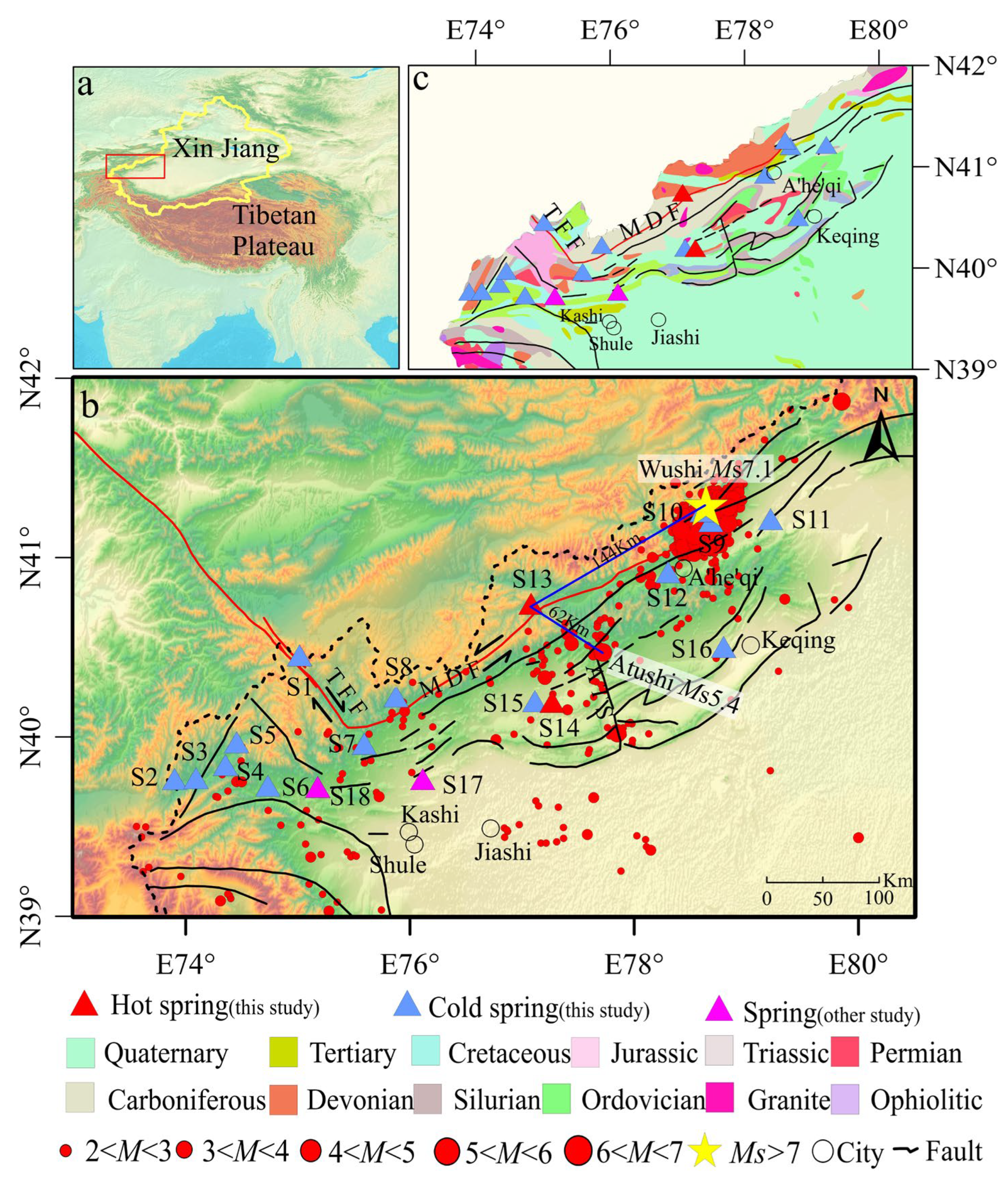
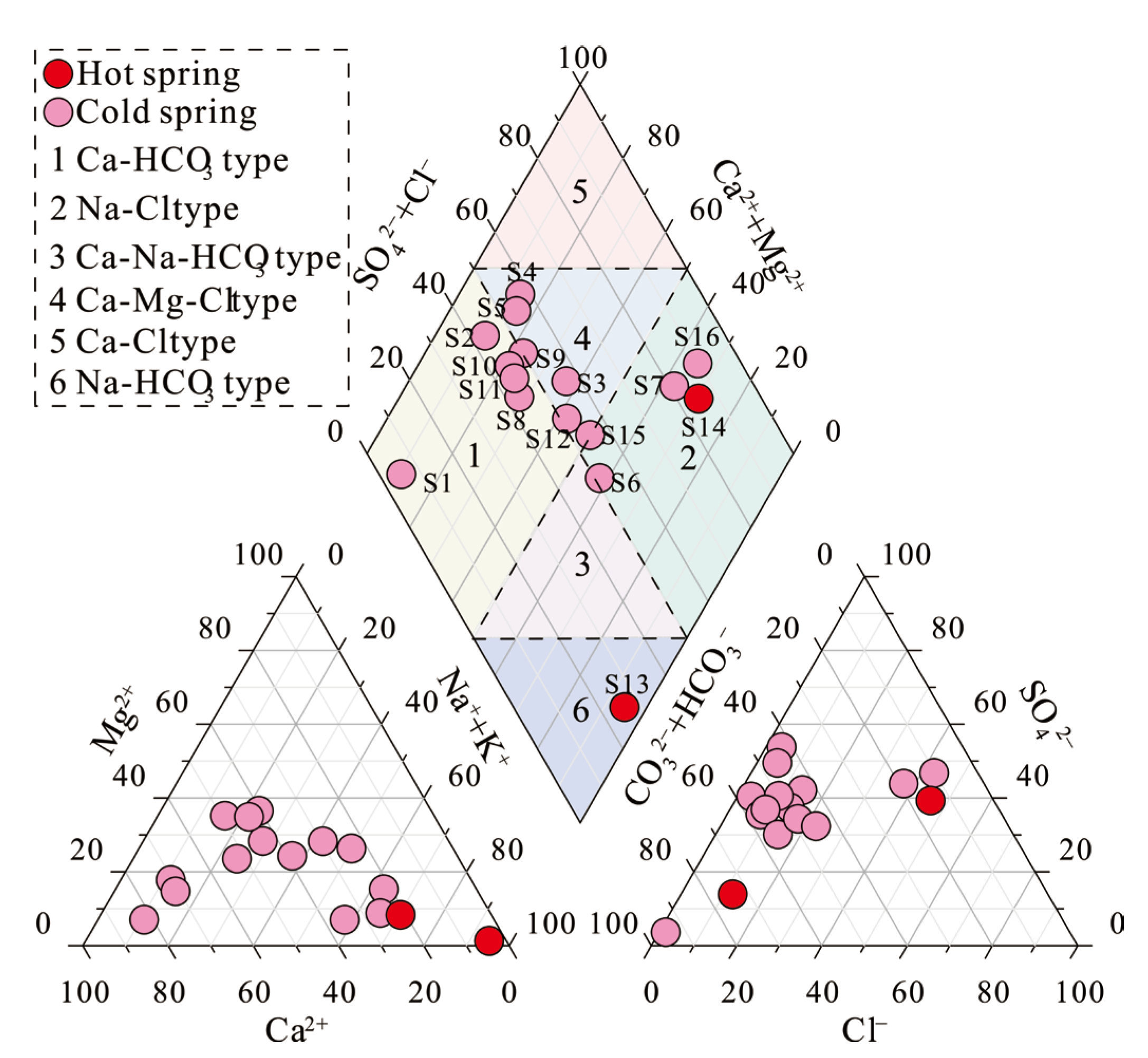
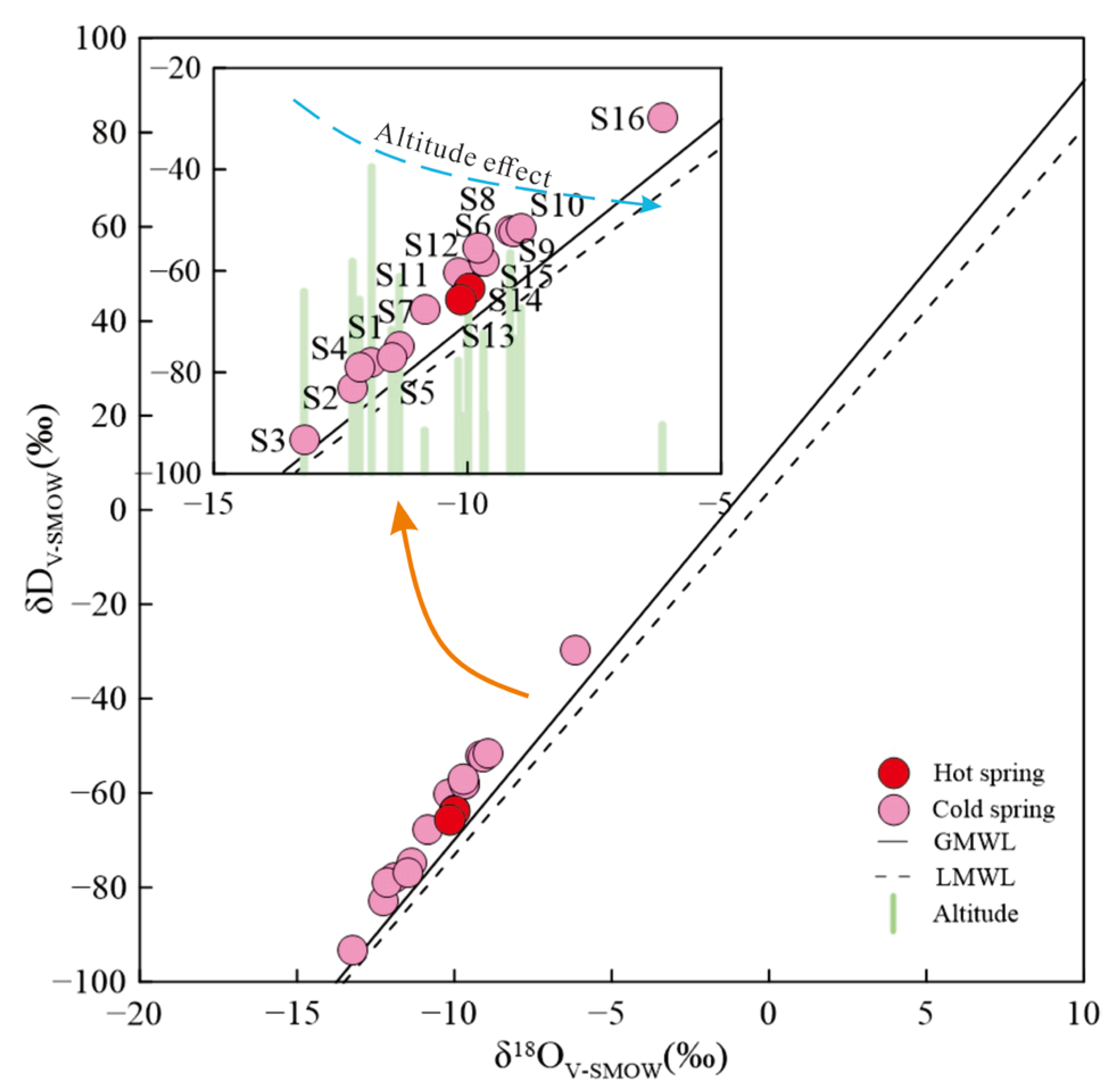
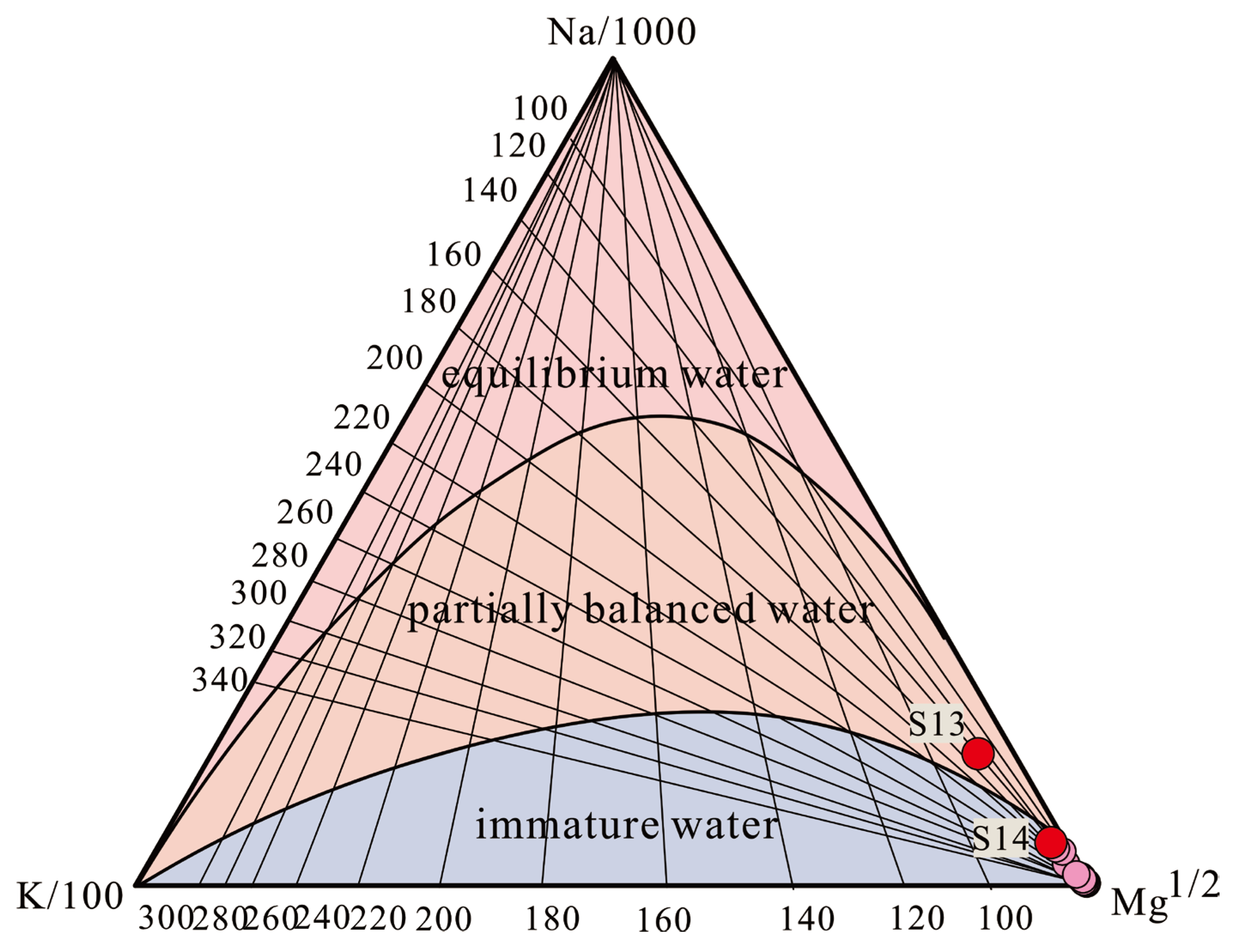
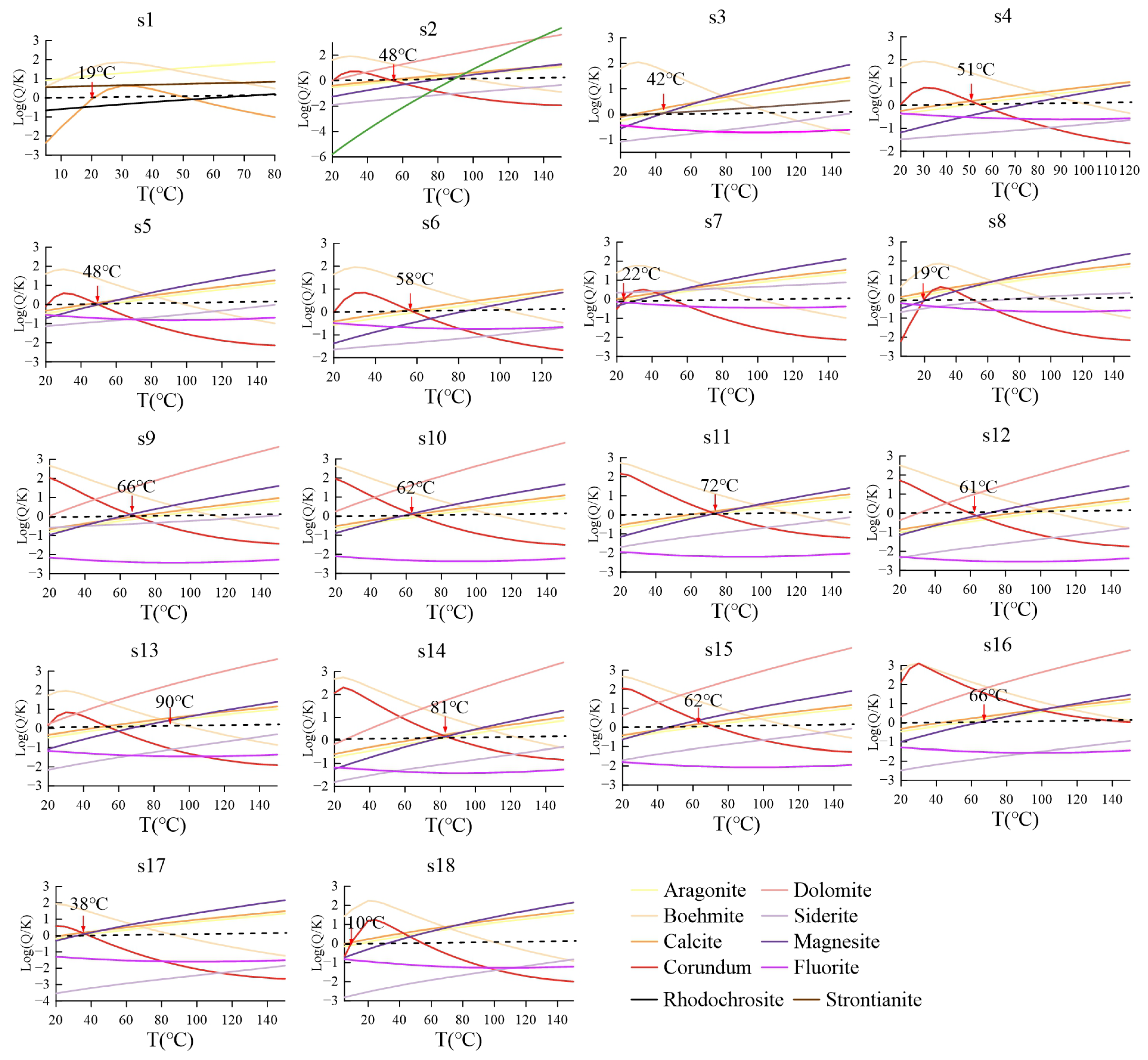
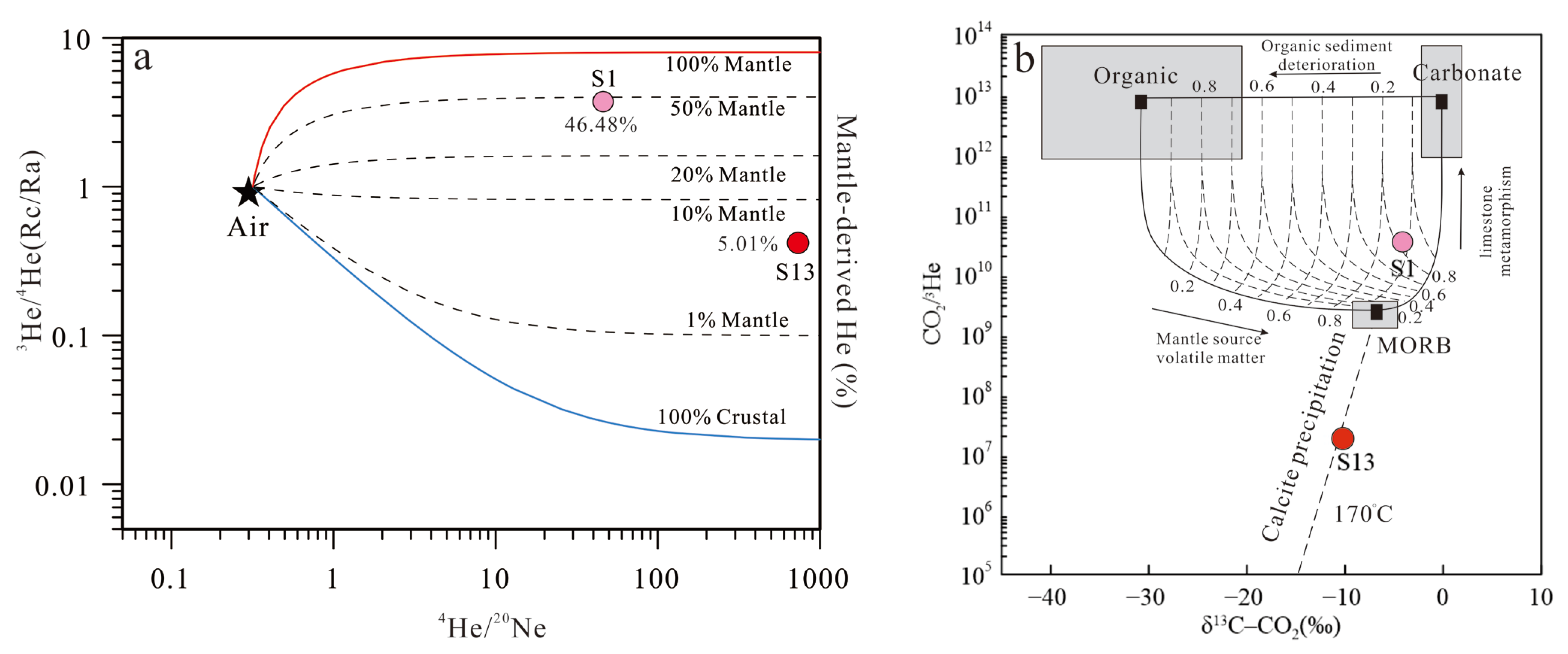
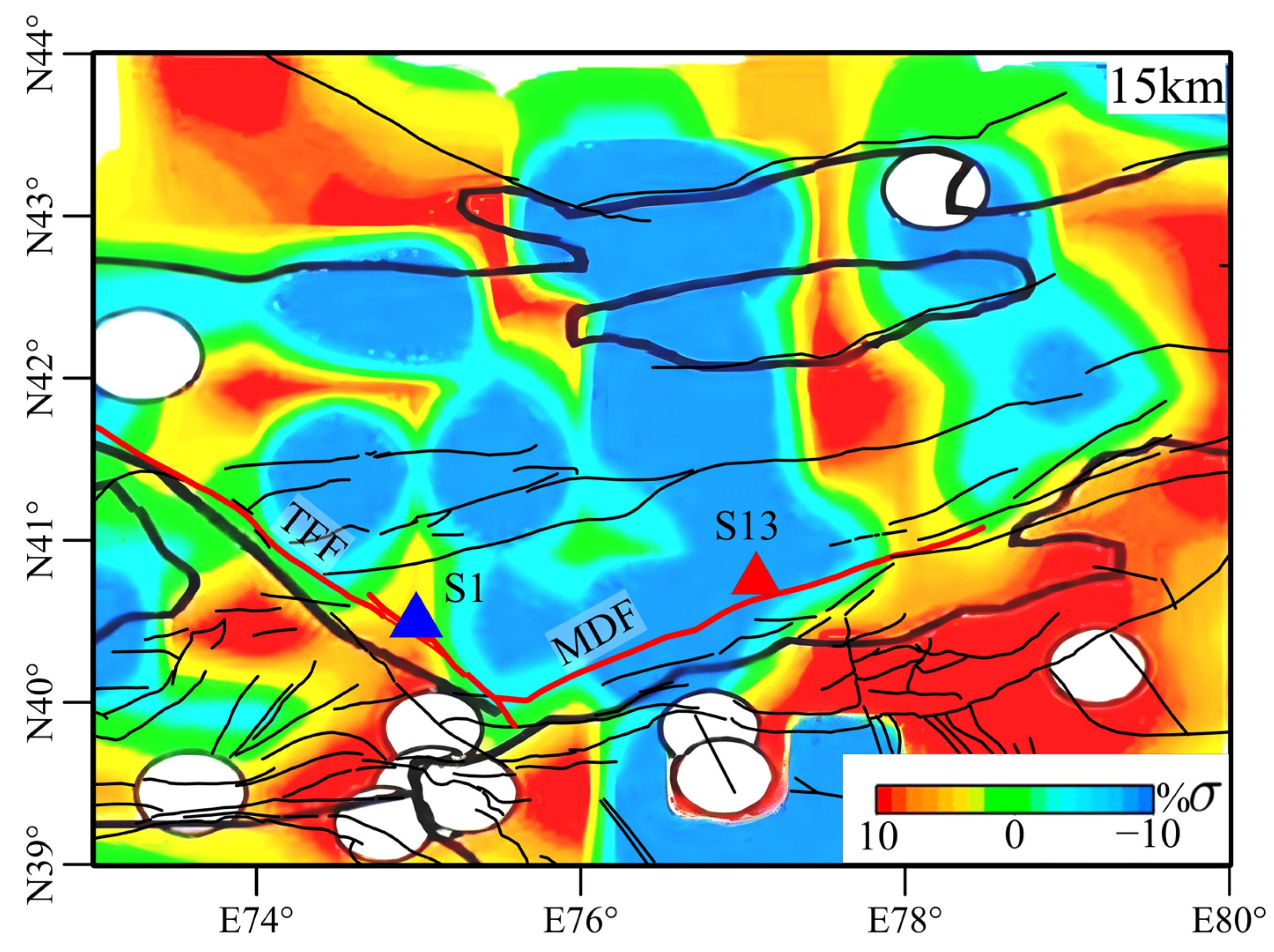
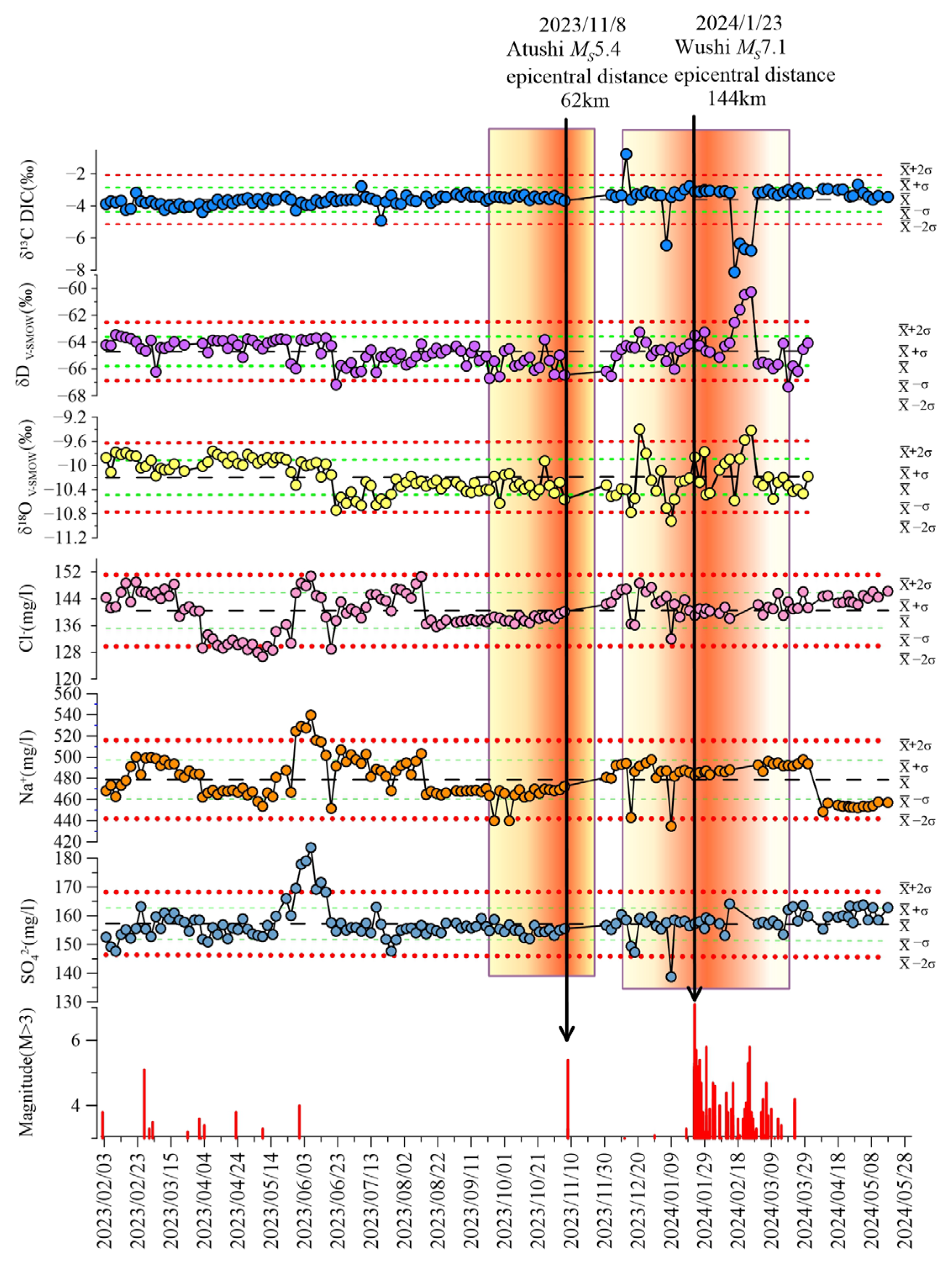
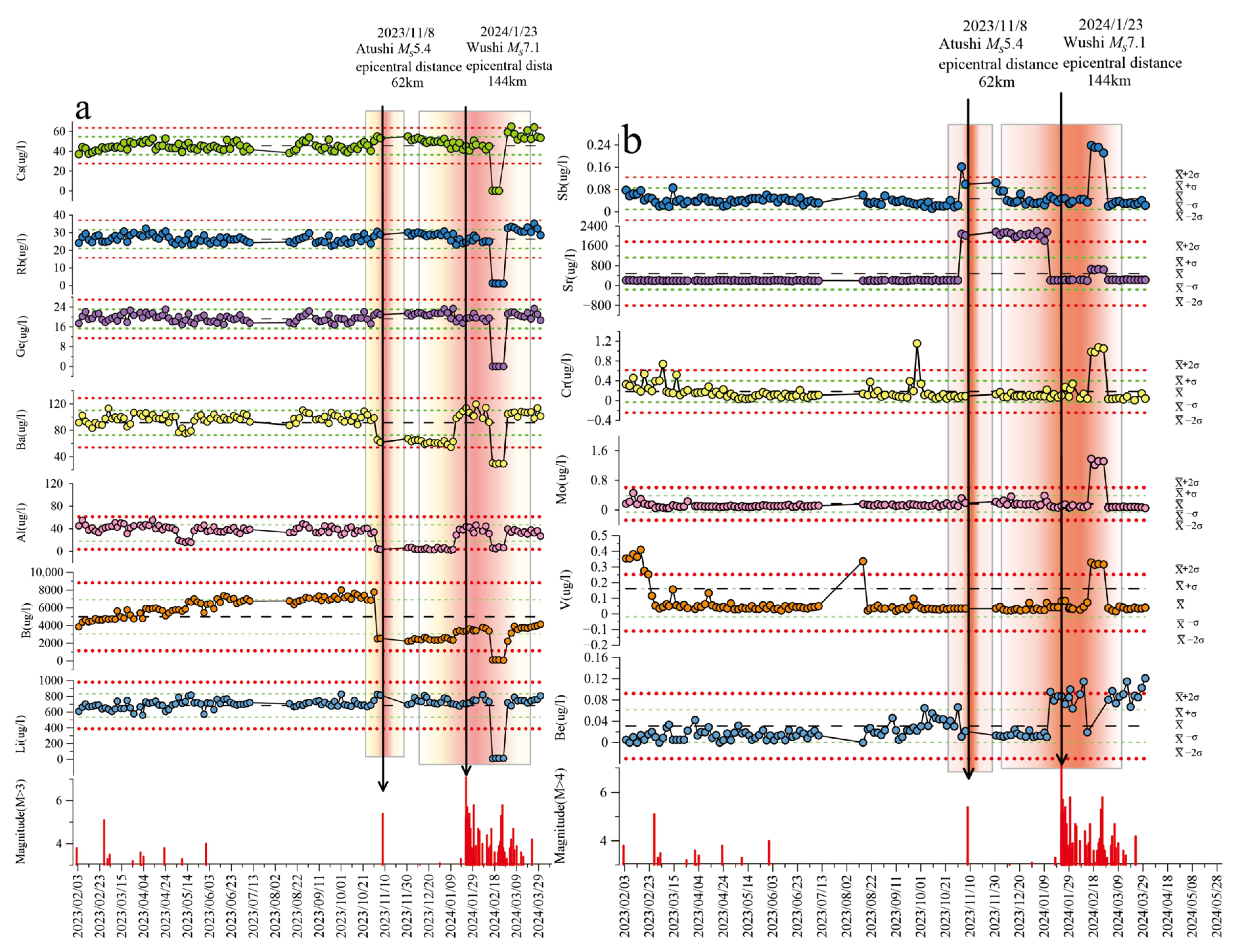
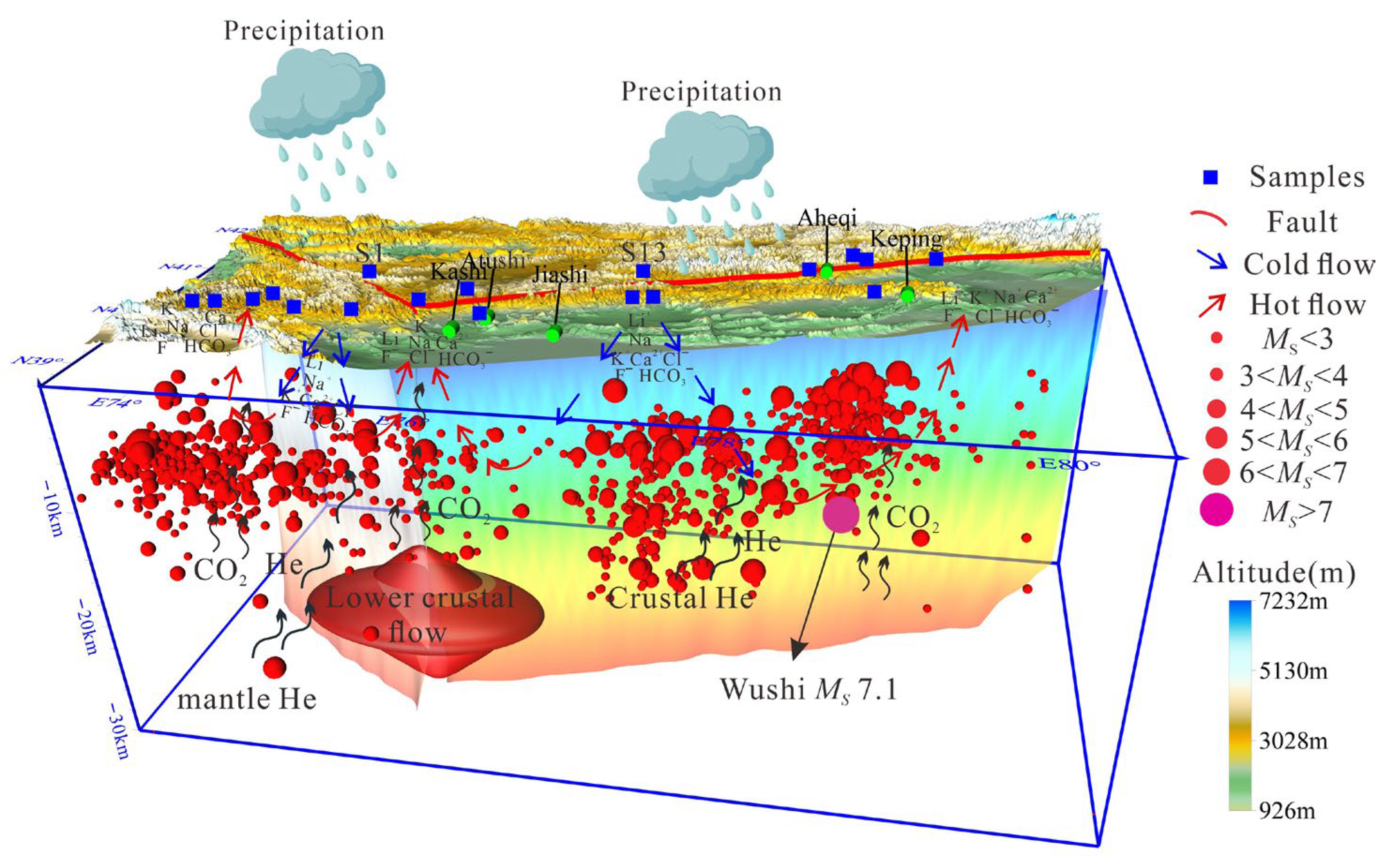
| Sample | He | H2 | CO2 | CH4 | O2 | N2 | Ar | 3He/4He | 4He/20Ne | CO2/3He | δ13C CO2 | a R/Ra | b Rc/Ra | c Mantle Percent | CO2 | ||
|---|---|---|---|---|---|---|---|---|---|---|---|---|---|---|---|---|---|
| ppm | ppm | % | % | % | % | % | ‰ | % | d O | e C | f M | ||||||
| S1(G1) | 7.6 | 1.1 | 98.06 | 0.01 | 0.32 | 1.62 | 0.02 | 5.20 × 10−6 | 46 | 3.49 × 1010 | −4.2 | 3.71 | 3.73 | 46.48 | 13.0 | 82.7 | 4.3 |
| S13(G2) | 6607.0 | 14 | 6.64 | 0.72 | 0.02 | 88.32 | 1.05 | 5.82 × 10−7 | 737 | 1.73 × 107 | −10.3 | 0.42 | 0.42 | 5.01 | - | - | - |
| Sample | Quartz, No Steam Loss (°C) | Quartz, Maximum Steam Loss (°C) | Chalcedony (°C) | Multicomponent Chemical Equibria (°C) | Average Reservoir Temperature (°C) | Average Reservoir Deepth (m) |
|---|---|---|---|---|---|---|
| S1 | 36.19 | 3.40 | 44.49 | 19.00 | 26 | 941 |
| S2 | 6.15 | - | 16.94 | 48.00 | 18 | 621 |
| S3 | 32.95 | 0.13 | 41.55 | 42.00 | 29 | 1076 |
| S4 | 16.82 | - | 26.79 | 51.00 | 24 | 856 |
| S5 | 23.05 | - | 32.51 | 48.00 | 26 | 946 |
| S6 | 24.04 | - | 33.42 | 58.00 | 29 | 1065 |
| S7 | 50.23 | 17.72 | 57.15 | 22.00 | 37 | 1381 |
| S8 | 26.02 | - | 35.23 | 19.00 | 20 | 712 |
| S9 | 14.35 | - | 24.52 | 66.00 | 26 | 959 |
| S10 | 14.92 | - | 25.04 | 62.00 | 25 | 930 |
| S11 | 23.75 | - | 33.15 | 72.00 | 32 | 1199 |
| S12 | 22.38 | - | 31.91 | 61.00 | 29 | 1063 |
| S13 | 99.06 | 68.93 | 100.18 | 90.00 | 90 | 3492 |
| S14 | 53.52 | 21.11 | 60.10 | 81.00 | 54 | 2067 |
| S15 | 55.00 | 22.63 | 61.42 | 42.00 | 45 | 1720 |
| S16 | 41.06 | 8.35 | 48.90 | 66.00 | 41 | 1553 |
| S17 | 21.60 | - | 31.19 | 38.00 | 23 | 818 |
| S18 | 31.14 | - | 39.90 | 10.00 | 20 | 720 |
Disclaimer/Publisher’s Note: The statements, opinions and data contained in all publications are solely those of the individual author(s) and contributor(s) and not of MDPI and/or the editor(s). MDPI and/or the editor(s) disclaim responsibility for any injury to people or property resulting from any ideas, methods, instructions or products referred to in the content. |
© 2025 by the authors. Licensee MDPI, Basel, Switzerland. This article is an open access article distributed under the terms and conditions of the Creative Commons Attribution (CC BY) license (https://creativecommons.org/licenses/by/4.0/).
Share and Cite
Zeng, Z.; Zhou, X.; Dong, J.; Li, J.; He, M.; Tian, J.; Wang, Y.; Yan, Y.; Yao, B.; Cui, S.; et al. Seismic Signals of the Wushi MS7.1 Earthquake of 23 January 2024, Viewed Through the Angle of Hydrogeochemical Characteristics. Appl. Sci. 2025, 15, 4791. https://doi.org/10.3390/app15094791
Zeng Z, Zhou X, Dong J, Li J, He M, Tian J, Wang Y, Yan Y, Yao B, Cui S, et al. Seismic Signals of the Wushi MS7.1 Earthquake of 23 January 2024, Viewed Through the Angle of Hydrogeochemical Characteristics. Applied Sciences. 2025; 15(9):4791. https://doi.org/10.3390/app15094791
Chicago/Turabian StyleZeng, Zhaojun, Xiaocheng Zhou, Jinyuan Dong, Jingchao Li, Miao He, Jiao Tian, Yuwen Wang, Yucong Yan, Bingyu Yao, Shihan Cui, and et al. 2025. "Seismic Signals of the Wushi MS7.1 Earthquake of 23 January 2024, Viewed Through the Angle of Hydrogeochemical Characteristics" Applied Sciences 15, no. 9: 4791. https://doi.org/10.3390/app15094791
APA StyleZeng, Z., Zhou, X., Dong, J., Li, J., He, M., Tian, J., Wang, Y., Yan, Y., Yao, B., Cui, S., Xing, G., Yan, H., Li, R., Zheng, W., & Cui, Y. (2025). Seismic Signals of the Wushi MS7.1 Earthquake of 23 January 2024, Viewed Through the Angle of Hydrogeochemical Characteristics. Applied Sciences, 15(9), 4791. https://doi.org/10.3390/app15094791






